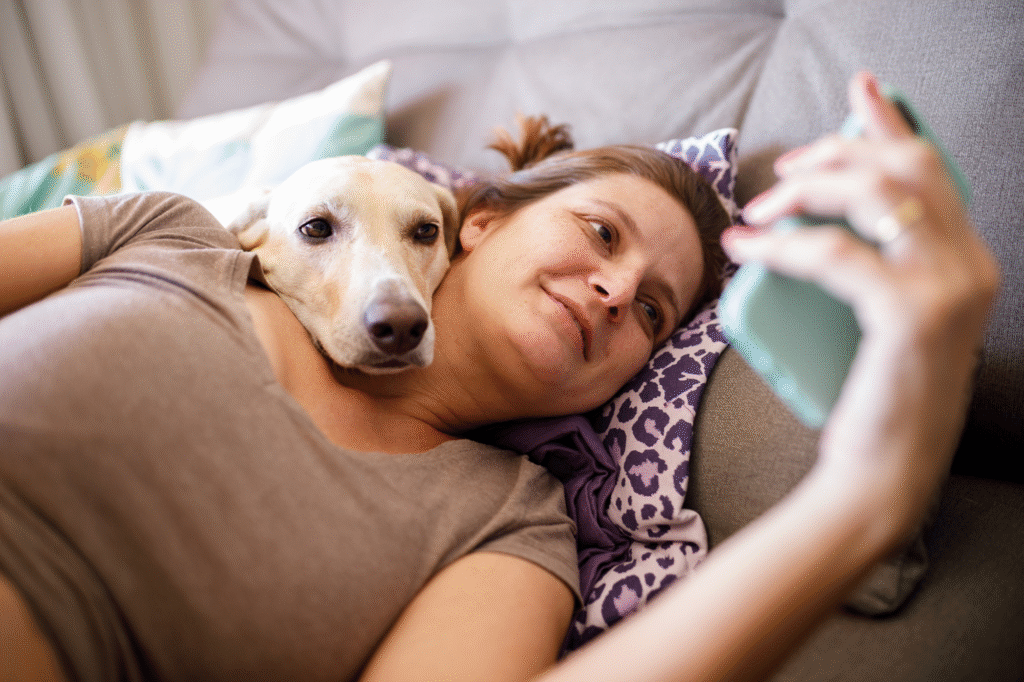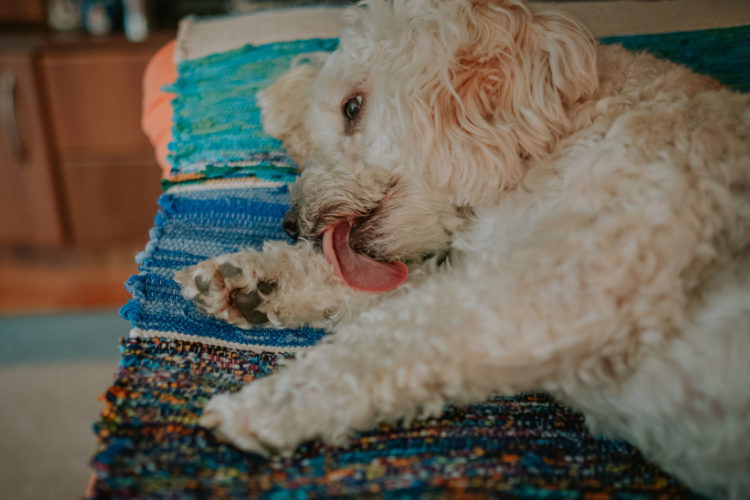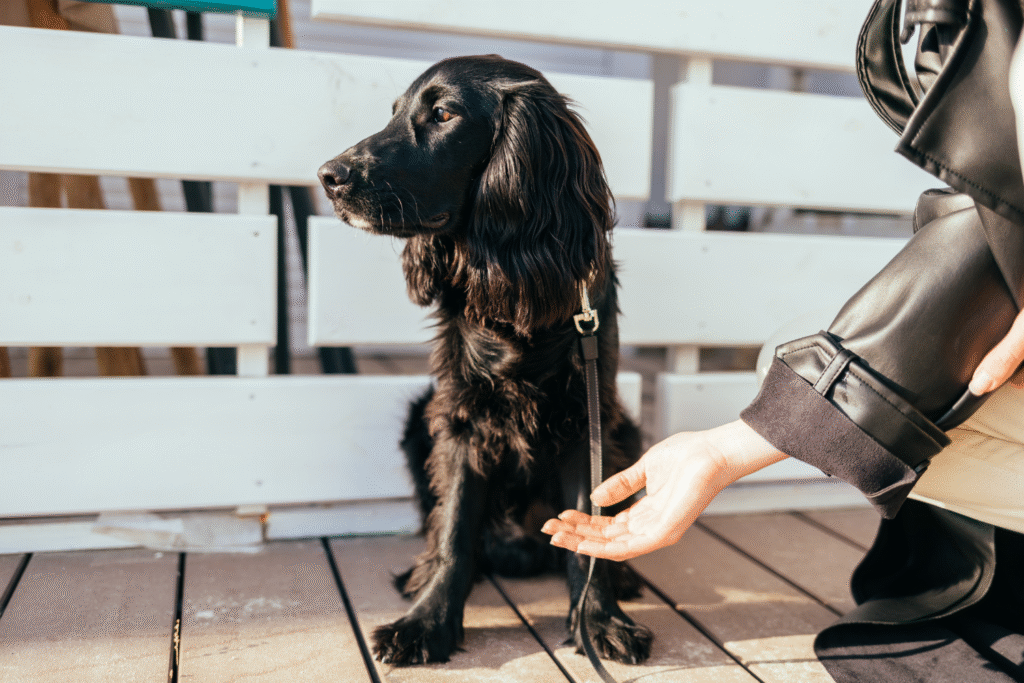Subtle signals that point to deeper distress.

Dogs often reveal their struggles in small ways long before the bigger signs appear. Many of these early hints seem harmless at first, blending into daily routines or getting brushed off as quirks. Yet as time passes, patterns form, and what once felt random suddenly looks connected. Anxiety has a way of reshaping behavior quietly, nudging dogs into habits that reflect stress they cannot put into words.
Owners who slow down and watch closely begin to notice how these moments stack together. Each behavior becomes part of a larger picture that shows how the body and mind influence each other. With the right support, dogs can return to calmer rhythms, but recognizing these signs early makes that journey far smoother and far less overwhelming.
1. Sudden changes in sleep patterns emerge quickly.

Dogs who once slept soundly may begin pacing at night or waking earlier than usual. The restless shifting often comes from internal tension that makes it hard for them to settle. Their body stays alert even when the house feels quiet. Over several days, you might see new sleep spots or hear soft footsteps in rooms they rarely visit. These subtle disruptions build on each other, turning routine rest into uneasy drifting.
As their sleep schedule continues to shift, their mood becomes more fragile. They may startle easily during the day or seem unusually clingy. The connection between anxiety and rest becomes clearer once you track these changes. Soon you notice how their energy dips and rises unpredictably, hinting at stress just beneath the surface.
2. Eating habits shift in unexpected ways.

Some anxious dogs lose interest in food, picking at meals they once devoured. Others eat faster, as if trying to outrun a feeling they cannot settle. The shift can appear out of nowhere, leaving you puzzled as bowls remain untouched or disappear at record speed. Their digestive system is closely tied to stress, so these changes are often early signs of emotional strain.
Over time, the disrupted eating pattern affects more than appetite. Their energy levels fluctuate, and minor stomach issues may appear. As you trace the pattern back, the connection to stress becomes harder to ignore. These moments often guide owners toward exploring emotional triggers that may be weighing heavily on their dog.
3. A dog begins licking excessively without clear cause.

Extended licking can look like grooming, but it often reflects anxiety as dogs seek comfort through repetitive motion. They may focus on paws, legs or even bedding. The rhythm becomes predictable, almost meditative, yet strangely urgent. As days pass, that soothing habit can turn into a compulsive cycle that your dog struggles to stop on their own.
The licking may lead to irritated skin or small patches of hair loss. These physical changes turn a subtle behavior into a visible sign that something deeper is happening. Once you see the pattern forming, it becomes easier to recognize the emotional layer behind the habit. This awareness gently leads you toward the next signs that anxiety may be shaping their daily life.
4. Clinginess increases when stress begins to rise.

Some dogs shadow their owners more closely than usual during anxious periods. They hover, check in often and follow every step with urgent focus. The behavior can seem sweet at first, but over time it reveals discomfort they struggle to manage alone. You may notice that they pause in doorways or pace when separated by even a small distance.
As anxiety deepens, the clinginess can impact their confidence. Dogs who once explored freely may stay within arm’s reach, unable to relax without constant reassurance. Their dependence becomes a window into their emotional state, guiding you to look at other ways anxiety shows up in their body.
5. Panting appears during calm moments indoors.

Panting is normal during heat or activity, but anxiety creates panting that appears seemingly without cause. Dogs might breathe rapidly in cool rooms or during restful times. Their chest rises quickly, and their eyes follow you with noticeable tension. The mismatch between their environment and their breathing often reveals stress building internally.
With ongoing anxiety, the panting becomes part of a larger pattern of physical arousal. The body tries to release energy it cannot contain, and breathing becomes one of the easiest outlets. As you watch this unfold, the connection to earlier signs such as clinginess or sleep changes becomes increasingly clear.
6. Digging at floors or bedding grows more frequent.

Some dogs begin pawing intensely at rugs, beds or even hard surfaces when anxiety rises. The movement often shows up during transitions such as bedtime or moments when the house settles. They dig with determination, almost as if trying to carve out a small pocket of safety. The habit builds quietly, turning into a nightly ritual that signals uneasy emotions.
Over time the digging can cause wear on bedding or leave marks on flooring. Owners who notice the pattern start to see how the behavior blends into a cycle of seeking control. The physical action becomes a way for dogs to release nervous energy when they cannot walk, run or rest easily.
7. Trembling surfaces in situations far from cold weather.

Shivering can stem from fear, excitement or temperature, but anxious dogs tremble in quiet settings too. Their body shakes lightly or noticeably as tension pulses through their muscles. The trembling often appears during routine moments such as car rides, grooming or even calm evenings. The lack of an obvious trigger signals an emotional layer beneath the surface.
As the trembling becomes more frequent, it often pairs with other behaviors like pacing or whining. These combinations deepen the story of stress shaping their daily life. Seeing how one signal reinforces another makes it easier to understand the scope of their anxiety.
8. Grooming routines become unusually intense or erratic.

Dogs normally groom to stay clean, but anxiety can amplify or disrupt the behavior. Some dogs groom obsessively while others stop grooming altogether. Their coat may look dull, uneven or slightly unkempt. The shift points to an internal struggle that interrupts their usual sense of order. This behavior often blends in with changes in appetite or sleep.
Over time the grooming change becomes more than a cosmetic issue. It speaks to a larger emotional imbalance that affects their overall well being. Noticing this helps owners connect the dots between subtle body care habits and underlying stress.
9. New avoidance behaviors appear without explanation.

Dogs who once enjoyed visitors, toys or certain rooms may begin avoiding them. The sudden hesitation suggests discomfort tied to emotion rather than preference. They linger in doorways, turn their heads or retreat quietly. The pattern can seem confusing until paired with other anxiety signs that make the reaction easier to interpret.
Eventually the avoidance begins influencing daily routines, creating small disruptions that ripple through the household. These avoidant moments act as whispers of stress, nudging owners to look deeper at what might be causing such sudden unease.
10. Vocalizing increases during typical quiet moments.

Dogs may whine or bark more than usual when anxiety builds. These sounds often emerge during calm times, indicating internal tension rather than external triggers. The tone may shift, growing softer or more persistent as they try to express distress. Owners often notice this change during evenings or early mornings when the home feels especially still.
As the vocalizing continues, it becomes clear that the dog is reaching for comfort or reassurance. The sound draws attention to their emotional landscape, linking back to earlier signs such as trembling or pacing. Together these moments paint a fuller picture that encourages compassionate, early intervention.
